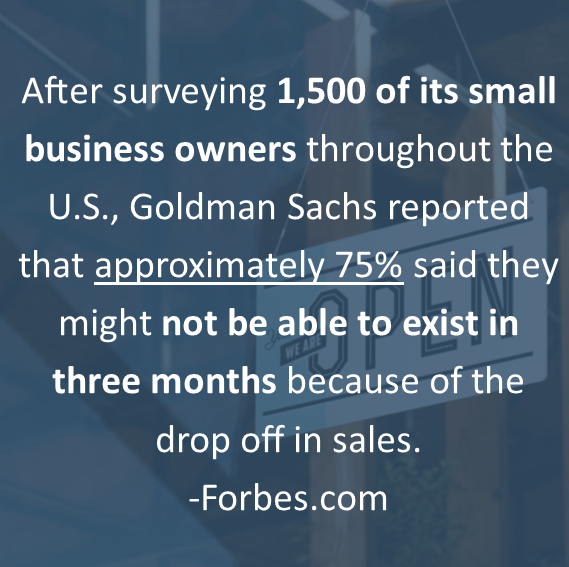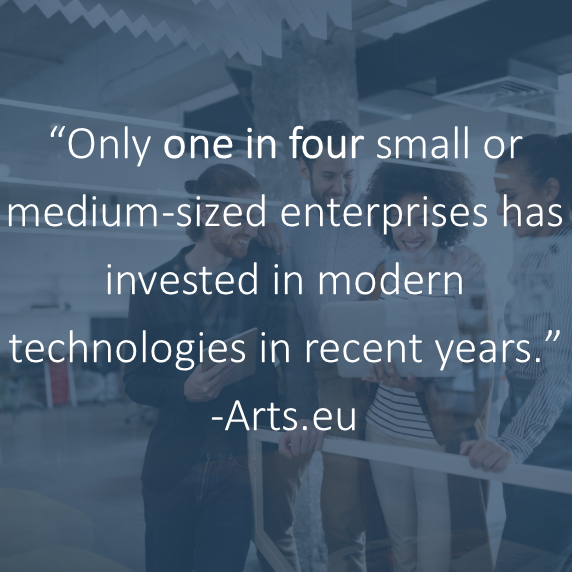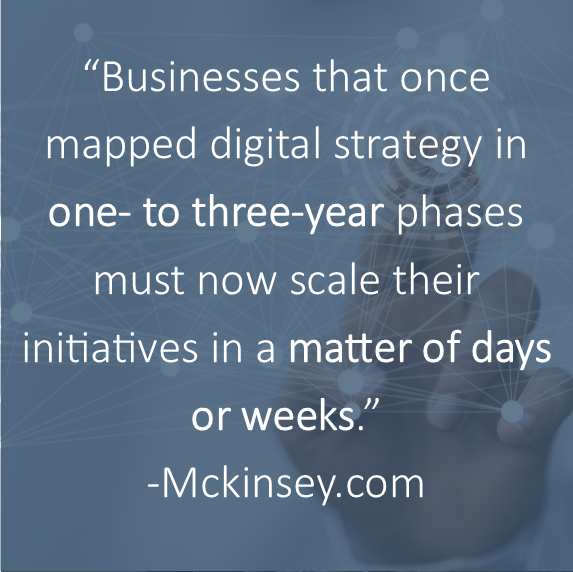Small and medium-sized enterprises (SMEs) are the backbone of our economy, making up 99.9% of all UK businesses.
Government data shows there were more than 35,600 medium-sized businesses in the UK at the start of 2019 (0.6%) and a further 7,700 large businesses (0.1%). At the same time, there were 5.82 million small businesses, making up 99.3% of the total business population. (MerchantSavvy.co.uk).
The current economic situation has forced many businesses to embrace digital, kick-starting their digital transformation journey early.
With the pandemic having such lasting effects on the economy, business owners are having to reevaluate the way they work, considering the best long-term strategy for survival of the business.
No one could have foreseen the damage the crisis would do to enterprises, not just throughout the UK but across the world.
In every country, we saw a dramatic drop in sales across all industries and sectors. Businesses of all shapes and sizes had to adjust to the rapidly changing markets.
Since the pandemic began, we have seen a huge switch – businesses are utilising digital like never before, concentrating on technology that enables remote working, online communication and group collaboration.
Companies have also been increasing their online presence and accessibility to consumers.
Governments have given support to individuals, SMEs, large businesses and multinationals.
In the UK, businesses have received extra funding with the government implementing the job retention scheme, reducing business taxes and introducing business rates relief, all in an effort to save our economy.
Although many businesses have been able to pull through the on-going crisis, sadly lots have not been so lucky.

Now is the time for SMEs to go digital.
Why Go Digital?
Digitalisation transforms the way businesses bring together customers, data and processes.
Pre pandemic, the introduction of digital transformation was seen as an option only some companies embraced. Although we were heading towards a digital world, many had not yet taken the first steps to ‘going’ digital.
There are many reasons why business owners would be hesitant about adopting digitisation and the idea of new ways of working.
Fear of change and a lack of understanding had been a key factor when looking at why businesses are reluctant to accept change.
‘The way we already do it works fine’ is an easy mindset to get stuck in when we are busy with our daily routine, however, going digital often offers a way of working smarter and faster.
The financial cost is another one of the main reasons why many businesses are reluctant to go digital, but as we believe at DriveWorks, you should always start small and work your way up.

Starting Small
Digital transformation should be focusing on adding value to every customer interaction and understanding the potential of your technology.
It doesn’t mean completely changing everything to be digital – altering the business all at once is not the way to approach this.
It’s all about integrating new technology and processes through to all areas of the business, rethinking old operating models, experimenting more to see what works best for you and ultimately becoming more agile in response to your customers and competitors.
Digital transformation can be different for all business structures, there is no one size fits all approach.
Up until this year, it has been an option, more than a necessity, for small and medium-sized enterprises to adopt digital. However, introduce a global pandemic and things have changed dramatically.
The introduction of national lockdowns and move to the home office has meant that digital is more important than ever, both in our work lives and home lives.
The power of technology connects people and processes in a way that works best for you.
Becoming Agile and Responsive
Now more than ever before we have seen the need for agility and responsiveness.
An organisation’s ability to adapt quickly to supply chain disruptions, time to market pressures, and rapidly changing customer expectations has become critical to survival.
Mark Anderson, Senior Director of Solution Architecture, Equinix, described this year as “a forced test of many things we had thought about but not tried.” (Enterprisersproject.com)
For enterprises who hadn’t yet begun their digital transformation journey, they were thrown into the deep end.
Whist those who had embraced digital found not only did they survive, they thrived.
Having the ability to quickly reinvent the way they work and sell meant business could carry on. For example, shop owners who normally sell products in-store began to sell online.
Creating an online presence and reaching customers in their homes has been a huge factor in staying competitive during this time.
SME’s can differ from industry to industry but no matter what the differences are, going digital is proven to be a key advantage pre and post-pandemic.
For many SMEs, the benefits of embracing new, emerging tech are huge.
Going digital can open up a wealth of opportunities for smaller businesses. For example, being able to compete against larger companies which in the past may have seemed impossible due to restricted budgets, pressures on time and resources, or low staff numbers.
Digital tools help SMEs streamline business processes, gain data-driven insights, increase productivity and improve communication all while keeping costs down.
Going digital will enhance SMEs competitiveness and understanding of consumer behaviours.
By adopting new technology and embracing digital, SMEs increase agility and enable further innovation in the future.
But How?
Now we have identified the need for business owners to embrace digitalisation, it’s important to understand how that can be achieved.
Driving change is easier said than done.
As I mentioned earlier, digital transformation is about adding value for the customer.
You shouldn’t be asking how you can do things faster, instead, look at your business processes and consider how you can adapt them to make the most of the technology you have invested in.
The same goes for digitalisation, rather than considering how you can change the business, focus on keeping things going the same but with the aim of working simpler and more efficient.
There are many tools and technologies on the market to help SMEs begin their digital journey.
Including cutting-edge technologies such as automation, blockchain, IoT, 5G, cloud computing, robots, AI, data science and many more.
It’s important to remember that technology will only assist if it is used correctly. There’s no point investing for the sake of it.

Many SMEs are looking for simple to use and simple to understand solutions that work for them.
Scalability is another thing to consider when planning your digital strategy.
We all know how fast things can change, and it’s important to keep in mind if the tools and technology are future proof.
Moving Forward
With the development of digital and the ongoing COVID-19 crisis, the future of the global economy will have everything to do with digitalisation.
Digital transformation holds a lot of value when trying to remain competitive, especially for SMEs competing with the larger players in their sector.
With the current economic situation constantly changing, there’s no time like the present to adopt digital and get on board so that your business can reap the rewards.

How is Automation Driving Digital Transformation?
Markets are changing, and customers are expecting more from the products and services they are buying. Consumers want products faster, cheaper and easier than ever before, without compromising on quality.
This is presenting a challenge for many businesses.
To meet demand, manufacturers are looking to automation.
Learn how automation is driving digital transformation in all industries in our digital transformation blog series.